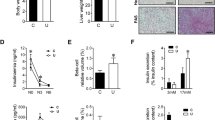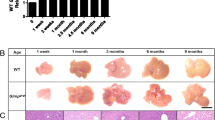Abstract
Autophagy is a lysosomal degradation process involved in the turnover of organelles or other cell constituents, in providing sources for energy production under starving conditions and in cell metabolism. A key protein in the macroautophagic machinery is the autophagy-related protein (Atg) 7. Constitutive deletion of Atg7 is lethal at birth. A conditional deletion of Atg7 in hepatocytes leads to hepatomegaly and in aged animals to liver tumors. With this study, we aim at analyzing the hepatomegaly development in more detail. The 3- to 4-fold enlargement of the liver takes place between days 25 and 35 after birth (P25–P35) and persists at least until P90. This is accompanied by a change in the expression of enzymes involved in the glycogen/glucose metabolism. While glycogen synthesis is inhibited, glucose is preferentially kept as glucose-6-phosphate inside the cells, inducing a swelling of the cells caused by hyperosmolarity. An increase of lipogenic enzymes suggests that glucose-6-phosphate is delivered to lipogenic pathways, which is supported by the occurrence of a steatosis around P30. The development of hepatomegaly is accompanied by a polyploidisation of hepatocytes, an enhanced expression of genes related to inflammatory processes and an infiltration of macrophages and granulocytes. Our data provide evidence that the attenuation of macroautophagy in hepatocytes leads to a glucose retention that causes cell swelling. The resulting hepatomegaly, which develops in a time interval of about 10 days, perturbs liver perfusion and induces an inflammatory reaction together with polyploidisation.







Similar content being viewed by others
References
Adhikary T, Kaddatz K, Finkernagel F, Schönbauer A, Meissner W, Scharfe M, Jarek M, Blöcker H, Müller-Brüsselbach S, Müller R (2011) Genomewide analyses define different modes of transcriptional regulation by peroxisome proliferator-activated receptor-β/δ (PPARβ/δ). PLoS ONE 6, e16344
Anding AL, Baehrecke EH (2015) Autophagy in cell life and cell death. Curr Top Dev Biol 114:67–91
Chou JY, Jun HS, Mansfield BC (2010) Glycogen storage disease type I and G6Pase-β deficiency: etiology and therapy. Nat Rev Endocrinol 6:676–688
Conesa-Zamora P, Torres-Moreno D, Isaac MA, Pérez-Guillermo M (2013) Gene amplification and immunohistochemical expression of ERBB2 and EGFR in cervical carcinogenesis. Correlation with cell-cycle markers and HPV presence. Exp Mol Pathol 95:151–155
Duncan AW (2013) Aneuploidy, polyploidy and ploidy reversal in the liver. Semin Cell Dev Biol 24:347–356
Duncan AW, Taylor MH, Hickey RD, Hanlon Newell AE, Lenzi ML, Olson SB, Finegold MJ, Grompe M (2010) The ploidy conveyor of mature hepatocytes as a source of genetic variation. Nature 467:707–710
Duncan AW, Hanlon Newell AE, Bi W, Finegold MJ, Olson SB, Beaudet AL, Grompe M (2012) Aneuploidy as a mechanism for stress-induced liver adaptation. J Clin Invest 122:3307–3315
Eliades A, Papadantonakis N, Matsuura S, Mi R, Bais MV, Trackman P, Ravid K (2013) Megakaryocyte polyploidy is inhibited by lysyl oxidase propeptide. Cell Cycle Georget Tex 12:1242–1250
Ezaki J, Matsumoto N, Takeda-Ezaki M, Komatsu M, Takahashi K, Hiraoka Y, Taka H, Fujimura T, Takehana K, Yoshida M, Iwata J, Tanida I, Furuya N, Zheng D-M, Tada N, Tanaka K, Kominami E, Ueno T (2011) Liver autophagy contributes to the maintenance of blood glucose and amino acid levels. Autophagy 7:727–736
Frawley LE, Orr-Weaver TL (2015) Polyploidy. Curr Biol 25:R353–R358
Ganley IG, Wong P-M, Gammoh N, Jiang X (2011) Distinct autophagosomal-lysosomal fusion mechanism revealed by thapsigargin-induced autophagy arrest. Mol Cell 42:731–743
Gebhardt A, Kosan C, Herkert B, Möröy T, Lutz W, Eilers M, Elsässer H-P (2007) Miz1 is required for hair follicle structure and hair morphogenesis. J Cell Sci 120:2586–2593
Gentleman RC, Carey VJ, Bates DM, Bolstad B, Dettling M, Dudoit S, Ellis B, Gautier L, Ge Y, Gentry J, Hornik K, Hothorn T, Huber W, Iacus S, Irizarry R, Leisch F, Li C, Maechler M, Rossini AJ, Sawitzki G, Smith C, Smyth G, Tierney L, Yang JYH, Zhang J (2004) Bioconductor: open software development for computational biology and bioinformatics. Genome Biol 5:R80
Görs S, Kucia M, Langhammer M, Junghans P, Metges CC (2009) Technical note: milk composition in mice--methodological aspects and effects of mouse strain and lactation day. J Dairy Sci 92:632–637
Guidotti J-E, Brégerie O, Robert A, Debey P, Brechot C, Desdouets C (2003) Liver cell polyploidization: a pivotal role for binuclear hepatocytes. J Biol Chem 278:19095–19101
Ha J, Guan K-L, Kim J (2015) AMPK and autophagy in glucose/glycogen metabolism. Mol Aspects Med (in press)
Hall AP, Elcombe CR, Foster JR, Harada T, Kaufmann W, Knippel A, Küttler K, Malarkey DE, Maronpot RR, Nishikawa A, Nolte T, Schulte A, Strauss V, York MJ (2012) Liver hypertrophy: a review of adaptive (adverse and non-adverse) changes--conclusions from the 3rd International ESTP Expert Workshop. Toxicol Pathol 40:971–994
Hao L, Ito K, Huang K-H, Sae-tan S, Lambert JD, Ross AC (2014) Shifts in dietary carbohydrate-lipid exposure regulate expression of the non-alcoholic fatty liver disease-associated gene PNPLA3/adiponutrin in mouse liver and HepG2 human liver cells. Metabolism 63:1352–1362
Hothorn T, Bretz F, Westfall P (2008) Simultaneous inference in general parametric models. Biom J Biom Z 50:346–363
Inami Y, Waguri S, Sakamoto A, Kouno T, Nakada K, Hino O, Watanabe S, Ando J, Iwadate M, Yamamoto M, Lee M-S, Tanaka K, Komatsu M (2011) Persistent activation of Nrf2 through p62 in hepatocellular carcinoma cells. J Cell Biol 193:275–284
Ito S, Karnovsky MJ (1968) Formaldehyde-glutaraldehyde fixatives containing trinitro compounds. J Cell Biol 39:168–169
Jochheim A, Hillemann T, Kania G, Scharf J, Attaran M, Manns MP, Wobus AM, Ott M (2004) Quantitative gene expression profiling reveals a fetal hepatic phenotype of murine ES-derived hepatocytes. Int J Dev Biol 48:23–29
Karsli-Uzunbas G, Guo JY, Price S, Teng X, Laddha SV, Khor S, Kalaany NY, Jacks T, Chan CS, Rabinowitz JD, White E (2014) Autophagy is required for glucose homeostasis and lung tumor maintenance. Cancer Discov 4:914–927
Klionsky DJ, Baehrecke EH, Brumell JH, Chu CT, Codogno P, Cuervo AM, Debnath J, Deretic V, Elazar Z, Eskelinen E-L, Finkbeiner S, Fueyo-Margareto J, Gewirtz D, Jäättelä M, Kroemer G, Levine B, Melia TJ, Mizushima N, Rubinsztein DC, Simonsen A, Thorburn A, Thumm M, Tooze SA (2011) A comprehensive glossary of autophagy-related molecules and processes (2nd edn). Autophagy 7:1273–1294
Komatsu M, Waguri S, Ueno T, Iwata J, Murata S, Tanida I, Ezaki J, Mizushima N, Ohsumi Y, Uchiyama Y, Kominami E, Tanaka K, Chiba T (2005) Impairment of starvation-induced and constitutive autophagy in Atg7-deficient mice. J Cell Biol 169:425–434
Kotoulas OB, Ho J, Adachi F, Weigensberg BI, Phillips MJ (1971) Fine structural aspects of the mobilization of hepatic glycogen. II. Inhibition of glycogen breakdown. Am J Pathol 63:23–36
Kotoulas OB, Kalamidas SA, Kondomerkos DJ (2004) Glycogen autophagy. Microsc Res Tech 64:10–20
Kotoulas OB, Kalamidas SA, Kondomerkos DJ (2006) Glycogen autophagy in glucose homeostasis. Pathol Res Pract 202:631–638
Kuma A, Hatano M, Matsui M, Yamamoto A, Nakaya H, Yoshimori T, Ohsumi Y, Tokuhisa T, Mizushima N (2004) The role of autophagy during the early neonatal starvation period. Nature 432:1032–1036
Laemmli UK (1970) Cleavage of structural proteins during the assembly of the head of bacteriophage T4. Nature 227:680–685
Lee IH, Kawai Y, Fergusson MM, Rovira II, Bishop AJR, Motoyama N, Cao L, Finkel T (2012) Atg7 modulates p53 activity to regulate cell cycle and survival during metabolic stress. Science 336:225–228
Livak KJ, Schmittgen TD (2001) Analysis of relative gene expression data using real-time quantitative PCR and the 2(-Delta Delta C(T)) Method. Methods San Diego Calif 25:402–408
Lum JJ, Bauer DE, Kong M, Harris MH, Li C, Lindsten T, Thompson CB (2005) Growth factor regulation of autophagy and cell survival in the absence of apoptosis. Cell 120:237–248
Martinez-Lopez N, Singh R (2015) Autophagy and lipid droplets in the liver. Annu Rev Nutr 35:215–237
McBride A, Hardie DG (2009) AMP-activated protein kinase--a sensor of glycogen as well as AMP and ATP? Acta Physiol (Oxford) 196:99–113
Michalopoulos GK (2010) Liver regeneration after partial hepatectomy: critical analysis of mechanistic dilemmas. Am J Pathol 176:2–13
Nascimbeni AC, Fanin M, Masiero E, Angelini C, Sandri M (2012) The role of autophagy in the pathogenesis of glycogen storage disease type II (GSDII). Cell Death Differ 19:1698–1708
Noda NN, Ohsumi Y, Inagaki F (2010) Atg8-family interacting motif crucial for selective autophagy. FEBS Lett 584:1379–1385
Olmo E (1983) Nucleotype and cell size in vertebrates: a review. Basic Appl Histochem 27:227–256
Raben N, Schreiner C, Baum R, Takikita S, Xu S, Xie T, Myerowitz R, Komatsu M, Van der Meulen JH, Nagaraju K, Ralston E, Plotz PH (2010) Suppression of autophagy permits successful enzyme replacement therapy in a lysosomal storage disorder--murine Pompe disease. Autophagy 6:1078–1089
Revel JP, Napolitano L, Fawcett DW (1960) Identification of glycogen in electron micrographs of thin tissue sections. J Biophys Biochem Cytol 8:575–589
Schneider JL, Cuervo AM (2014) Liver autophagy: much more than just taking out the trash. Nat Rev Gastroenterol Hepatol 11:187–200
Schoenfelder KP, Fox DT (2015) The expanding implications of polyploidy. J Cell Biol 209:485–491
Sica V, Galluzzi L, Bravo-San Pedro JM, Izzo V, Maiuri MC, Kroemer G (2015) Organelle-specific initiation of autophagy. Mol Cell 59:522–539
Singh R, Kaushik S, Wang Y, Xiang Y, Novak I, Komatsu M, Tanaka K, Cuervo AM, Czaja MJ (2009) Autophagy regulates lipid metabolism. Nature 458:1131–1135
Takamura A, Komatsu M, Hara T, Sakamoto A, Kishi C, Waguri S, Eishi Y, Hino O, Tanaka K, Mizushima N (2011) Autophagy-deficient mice develop multiple liver tumors. Genes Dev 25:795–800
Wilson EB (1925) The cell in development and heredity. Macmillan, New York
Xiong J (2015) Atg7 in development and disease: panacea or Pandora’s Box? Protein Cell 6:722–734
Yang L, Li P, Fu S, Calay ES, Hotamisligil GS (2010) Defective hepatic autophagy in obesity promotes ER stress and causes insulin resistance. Cell Metab 11:467–478
Acknowledgments
We thank Waltraud Ackermann and Uschi Lehr for their excellent technical assistance and David Fuhrmann for critically reading the manuscript.
Author information
Authors and Affiliations
Corresponding author
Electronic supplementary material
Below is the link to the electronic supplementary material.
ESM 1
(PDF 261 kb)
Rights and permissions
About this article
Cite this article
Kern, L., Spreckels, J., Nist, A. et al. Altered glycogen metabolism causes hepatomegaly following an Atg7 deletion. Cell Tissue Res 366, 651–665 (2016). https://doi.org/10.1007/s00441-016-2477-8
Received:
Accepted:
Published:
Issue Date:
DOI: https://doi.org/10.1007/s00441-016-2477-8




